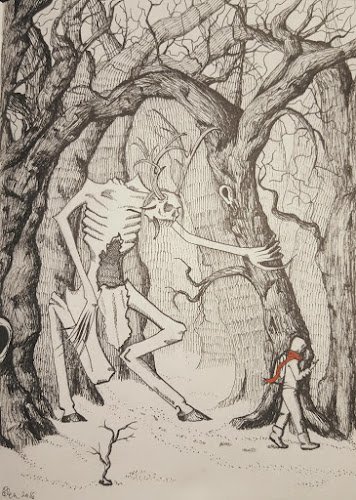 |
| Modern Wendigo by skeletoninadress |
This is a creature that possesses humans under conditions of extreme cold and hunger and gets them to become cannibals. Also, people that engaged in cannibalism were also at greater risk of possession.
The Wendigo is a spirit most times, unable to physically manifest in the world or interact with it. That is until someone in a cold part of the world begins to despair and go hungry. There are plenty of places in the world that are cold and these have hungry people, the Wendigo though chooses someone though that has or will resort to cannibalism to stay alive. Once this is done the Wendigo has access to the victim's heart.
With their heart frozen the victim becomes the physical Wendigo. They appear lean and gaunt, but taller; as if stretched out. Their hands become claws with vile blue talons. Their entire appearance becomes more feral. They appear to be something akin to a ghoul or even a starving were-wolf mid-transformation. They are constantly hungry, eating all the flesh they can, though they never eat their fill. Eventually, the wendigo strains the host body too much and they die completely in a number of weeks. Though there are rumors of giant wendigo, whose heads reach the clouds that are thousands of years old.
I included the Wendigo and the more powerful Wendigo Matron in my The Winter Witch for Swords & Wizardry. Here it is for other games.
Wendigo
No. Appearing: 1-2
AC: 3
Move: 45ft.
Hit Dice: 8
Special: 3 attacks (2 claws, bite) + Breath weapon, Enhanced Senses, Immunity to Cold, Immunity to Normal Weapons, Requires Blessed weapon to hit.
XP VALUE: 1,280
This creature shares a number of characteristics with were-creatures and undead. Ancient people believed that only a tribal shaman could bless a weapon that would kill both the host body and the wendigo spirit.
The wendigo is completely immune to all cold-based attacks. It attacks with its claws and bite and can emit a blast of freezing cold air up 3 times per day for 1d6+5 hp of damage (save for half).
Ordinary World: Wendigos are known to exist in the Ordinary World, but few even among the supernatural community have encountered them. They are generally feared to be unpredictable and very, very dangerous.
Valhalla, AK: Everyone in Valhalla "knows" that there are "wendigos" north of the town. The locals though will point out that the creature everyone thinks is a wendigo is actually the wechuge ("way-chu-gay"). Someone can become a wechuge by breaking a tribal taboo or becoming too prideful.
Some of the indigenous locals still remember tales from their grandparents and great-grandparents of the horrible winters of long ago where you could hear the howls of the wechuge/wendigo.
Wendigo
Armor Class: 2
No. Appearing: 0 / 1d3
Hit Dice: 8
Save As: F8
Movement: 150/50
Attacks: 3 claw/claw/bite
Damage: 1d6/1d6/1d8
Special Attacks: Breath weapon (cold) 1d8+5
Special Defense: Immune to cold-based attacks, immune to normal weapons, requires a blessed weapon to hit
Intelligence: 4 (devious cunning)
Morale: 11
Treasure Type: None
Alignment: Chaos
THACO: 12
Experience: 1,750
This creature shares a number of characteristics with were-creatures and undead. Ancient people believed that only a tribal shaman/cleric could bless a weapon that would kill both the host body and the wendigo spirit. A cleric can turn one as a Special Undead. Once a person is infected with a wendigo they can not be cured.
The wendigo is completely immune to all cold-based attacks. It attacks with its claws and bite and can emit a blast of freezing cold air up 3 times per day for 1d6+5 hp of damage (save for half).
Wendigo
No. Encountered: 0 (1d4)
Alignment: Chaotic Evil
Size: L
Movement: 50
Dexterity: 12
Armour Class: 2
Hit Dice: 8
Attack Rate: 3/1 (claw / claw / bite) + breath weapon (cold) x3
Damage: 1d6 / 1d6 / 1d8 + 1d8+5
Special: Immune to cold-based attacks, immune to normal weapons, requires a blessed weapon to hit
Saving Throw: 12
Morale: 11
Experience Points: 1,000
Treasure Class: None
The wendigo are believed to have been first created by Ythaqqa.
They can be turned as undead type 13.


















